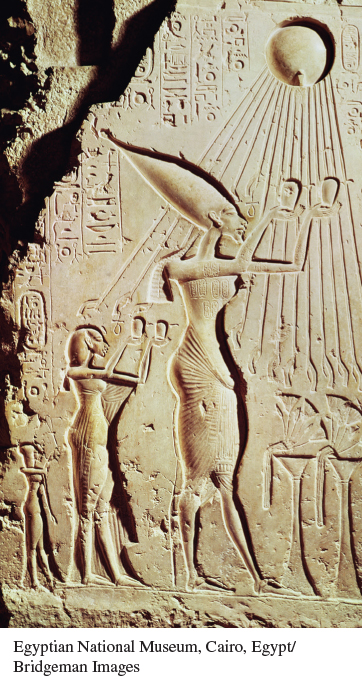A History of Western Society: Printed Page 18
Thinking Like a Historian
Addressing the Gods
Hymns and incantations to the gods are among the earliest written texts in Mesopotamia and Egypt, and sculpture and paintings also often show people addressing the gods. The sources here are examples of such works. What ideas about the gods and the way humans should address them are shared in all these sources, and how do ideas in Egypt differ from those in Mesopotamia?
| 1 | Enheduana’s “Exaltation of Inanna.” Enheduana (2285–2250 B.C.E.), the daughter of Sargon of Akkad, was appointed by her father as high priestess in the Sumerian city of Ur, where she wrote a number of literary and religious works that were frequently recopied long after her death, including this hymn to the goddess Inanna. |
![]() Your divinity shines in the pure heavens. . . .
Your divinity shines in the pure heavens. . . .
I am En-
| 2 |
Babylonian cylinder seal showing a man addressing the deities. Dating from the Old Babylonian period (1800–1600 B.C.E.), this seal shows a man (second from left) addressing three deities, the one on the right holding the rod and ring, symbols of authority. The cuneiform inscription reads, “Ibni- |

| 3 | Pyramid text of King Unas. This incantation, designed to assist the king’s ascent to the heavens after his death, was inscribed on a wall of the royal burial chambers in the pyramid of the Egyptian king Unas (r. 2375–2345) at Saqqara, a burial ground near the Nile. |
![]()
Re-
A spirit indestructible
Who lays claim to the place of the four pillars!
Your son comes to you, this Unas comes to you
May you cross the sky united in the dark,
May you rise in lightland, the place in which you shine!
Osiris, Isis, go proclaim to Lower Egypt’s gods
And their spirits:
“This Unas comes, a spirit indestructible,
Like the morning star above Hapy [the god of the flooding of the Nile],
Whom the water-
Whom he wishes to live will live,
Whom he wishes to die will die!”
. . .
Thoth [the god of law and science], go proclaim to the gods of the west
And their spirits:
“This Unas comes, a spirit indestructible,
Decked above the neck as Anubis
Lord of the western height
He will count hearts, he will claim hearts,
Whom he wishes to live will live,
Whom he wishes to die will die!”
| 4 |
Hymn to Aton. When the pharaoh Akhenaton (r. 1351–1334 B.C.E.) promoted the worship of the sun- |
![]() Thou appearest beautifully on the horizon of heaven
Thou appearest beautifully on the horizon of heaven
Thou living Aton, the beginning of life!
When thou art risen on the eastern horizon,
Thou hast filled every land with thy beauty.
Thou art gracious, great, glistening, and high over every land;
Thy rays encompass the lands to the limit of all that thou hast made
. . .
Thy rays suckle every meadow.
When thou risest, they live, they grow for thee.
Thou makest the seasons in order to rear all that thou hast made,
The winter to cool them,
And the heat that they may taste thee.
Thou hast made the distant sky in order to rise therein,
In order to see all that thou dost make.
While thou wert alone,
Rising in thy form as the living Aton,
Appearing, shining, withdrawing or approaching,
Thou madest millions of forms of thyself alone.
Cities, towns, fields, road, and river —
Every eye beholds thee over against them,
For thou art the Aton of the day over the earth . . .
Thou art in my heart,
And there is no other that knows thee
Save thy son Nefer-
For thou hast made him well versed in thy plans and in thy strength . . .
Since thou didst found the earth
And raise them up for thy son
Who came forth from thy body:
The king of Upper and lower Egypt, . . .
| 5 |
Relief depicting Akhenaton, Nefertiti, and their daughter, Meritaton, making an offering to Aton. This carved alabaster relief comes from the royal palace at Tell el- |

ANALYZING THE EVIDENCE
- In Source 1 from Mesopotamia, what powers and qualities of the goddess Inanna does Enheduana praise? In Source 2, what qualities do the deities in the cylinder seal exhibit?
- In Sources 3–
5 from Egypt, what powers and qualities does the sun- god exhibit? - What common features do you see across all the sources in the powers ascribed to the gods, and the proper attitude of humans in addressing them?
- Continuing to think about similarities, bear in mind that Enheduana was a member of the ruling dynasty of Akkad, and Unas and Akhenaton were kings of Egypt. How did their social position shape their relationship to the gods?
- Thinking about differences, how is the relationship of Unas and Akhenaton to the sun-
god distinctive?
PUTTING IT ALL TOGETHER
Using the sources above, along with what you have learned in class and in this chapter, write a short essay that compares ideas about the gods in Mesopotamia and Egypt. How do these reflect the physical environment in which these two cultures developed, and how do they reflect their social and political structures?
Sources: (1) J. A. Black et al., Electronic Text Corpus of Sumerian Literature (http://etcsl.orinst.ox.ac.uk/), Oxford 1998–2006, http://etcsl.orinst.ox.ac.uk/cgi-